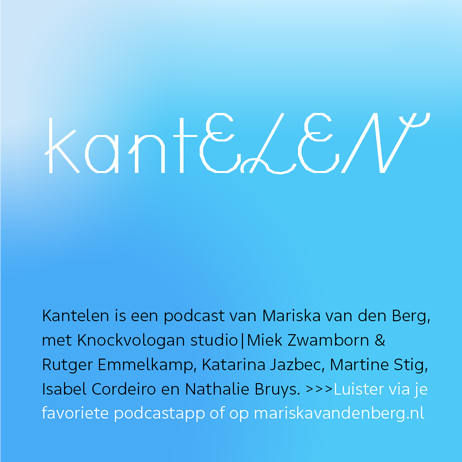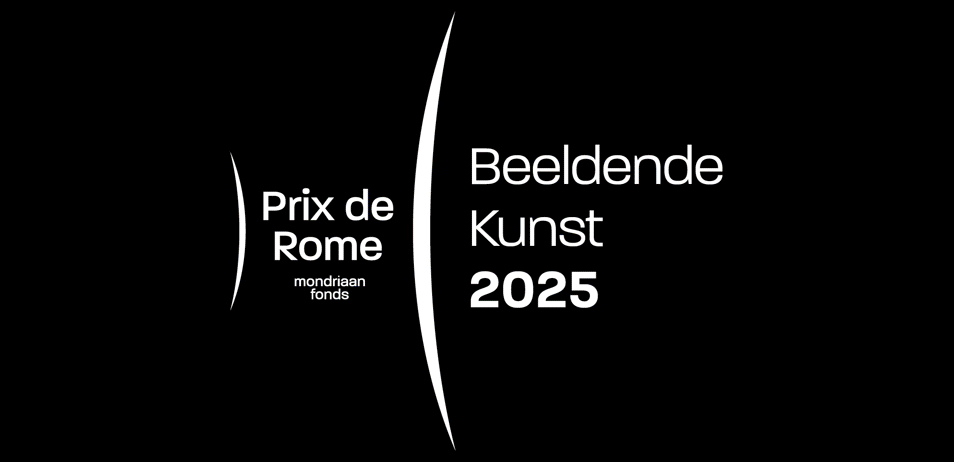Het werk begint, je kunt het van een afstand horen – over Sonsbeek (Force Times Distance), over arbeid en zijn sonische ecologieën, in twee bezoeken – en misschien nog meer
Ik ben te laat voor de fysieke persvertoning op 30 juni, maar ik kijk digitaal mee. Ik kijk naar de opening van de vierjaarlijkse tentoonstelling Sonsbeek in Arnhem, die plaatsvindt in de Eusebius kerk, tussen een zoombijeenkomst om een festival te organiseren en een persoonlijke afspraak om een nieuw paar Airpods in Amsterdam op te halen. Na een maand eerder de linker te hebben verloren, luister ik (met alleen mijn rechteroor) via een Instagram-livestream, waar verder een paar dozijn andere mensen naar luisteren. Een stroom koormuziek en toespraken (de festivaldirecteur: Bonaventure Sou Bejeng Ndikung, een van de curatoren, Amal Alhaag) druppelt mijn rechteroor in, terwijl het lawaai van het middagverkeer de linker in sijpelt.
Vertaling: Jesse Lemmens (scroll down for the English version)
Tijdens de lunch stopte ik mijn nieuw gekochte Airpods – ontworpen in Californië, gemaakt in Vietnam, gedistribueerd via Ierland – in mijn rugzak en ging naar het station op weg naar Arnhem.
Voor dit stuk krijg ik 0.20 cent per woord. En mijn vertaler zal een vergoeding van 250 euro ontvangen. Het is zinvol om het te benoemen. Dit stuk en Sonsbeek zelf gaan over arbeid, over ecologie, over soundscapes. Over hoe je vanaf 2021 een uitwaaierende tentoonstelling kunt organiseren op basis van deze onderwerpen. Het is een uitdaging dit alles te omvatten, dus ik zal niet eens doen alsof het me lukt.
Eenmaal op Molenplaats, in park Sonsbeek, ga ik zitten en bestel een koffie en beide catalogi van de tentoonstelling bij een stagiair, die mij vergeet om geld te vragen. Ik denk bij mezelf: “Dit moet gelukzalig zijn! We zijn beland in een post-werk-utopie!”, totdat haar supervisor aangeeft dat ik moet betalen en we voorzichtig met beide benen terug op de grond worden gezet. Ze geeft me de catalogi, een tote bag en een plastic fles water met het Albert Heijn-logo erop, terwijl ik mezelf knijp en probeer te begrijpen waar ik ben. Een flyer op de tafel helpt me. Ik zit in “a beautiful mess”, een initiatief dat betaalde banen aanbiedt aan mensen met een vluchtelingenachtergrond, via leertrajecten. Het is een elegante manier om het thema van de show te integreren, maar niet een onderdeel van de show zelf.
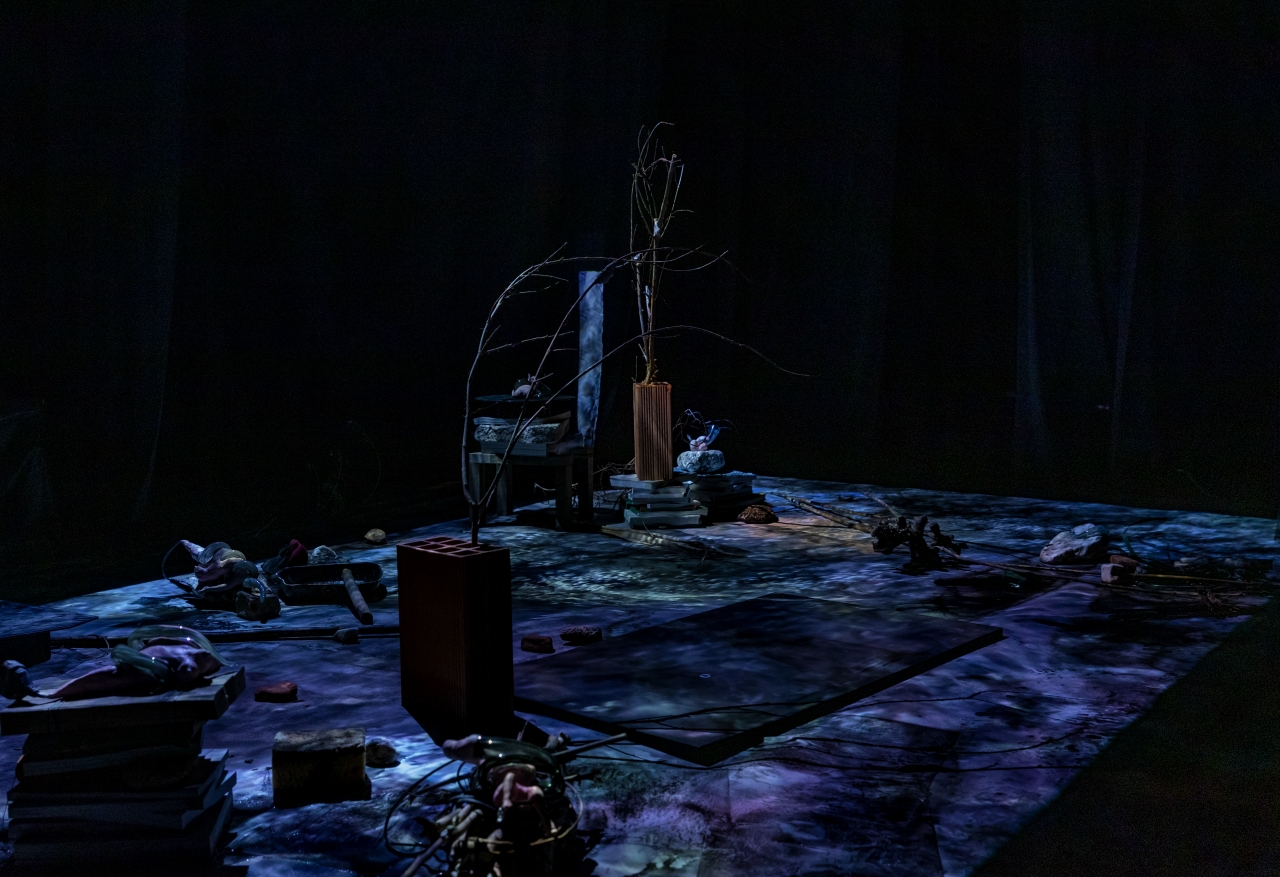
Ik besluit de ongeleide route te nemen en stap langs de kant van de weg. Ik zie mezelf als een regelmatige bezoeker, dus mis ik veel van de festiviteiten.
Ik meander via de groene route naar DE.GROEN, waar ik een olfactorische reis doormaak, van vanille naar inktvis, van boven en door de cadeauwinkel naar beneden in de kelder. Het is de eerste dag, nog niet alle presentaties zijn compleet. Een reeks instructies ligt op de bank naast het inktwerk van Laure Prouvost; de notities zijn handgeschreven en bespreken alles; van hoe er met de elektronica moet worden omgegaan tot hoe het publiek moet worden verzorgd. Idealiter zouden de toeschouwers thee worden geserveerd.
Op de persdag is Showroom Arnhem gesloten. In plaats daarvan struikel ik over een Appeltje Eitje – wat zou er gebeuren als een FEBO zou worden gekruist met een automatische supermarktcheck-out en een boerenmarkt – en ik probeer me voor te stellen aan welke kunstenaar het toebehoort. Daarin zijn de werknemers volledig weg-geautomatiseerd. Enkele verhalen over de oorsprong van boeren en vooraf opgenomen video’s vullen de muren en men is vrij om een self-check-out en een muur vol verse producten (fruit, eieren, melk, kippenvlees te volgen en te betalen op de display – contactloos natuurlijk). De winkel lijkt elegant te integreren wat ik later ontdekte dat Sonsbeek niet echt aanpakt; de toekomst van het werk in het licht van automatisering.
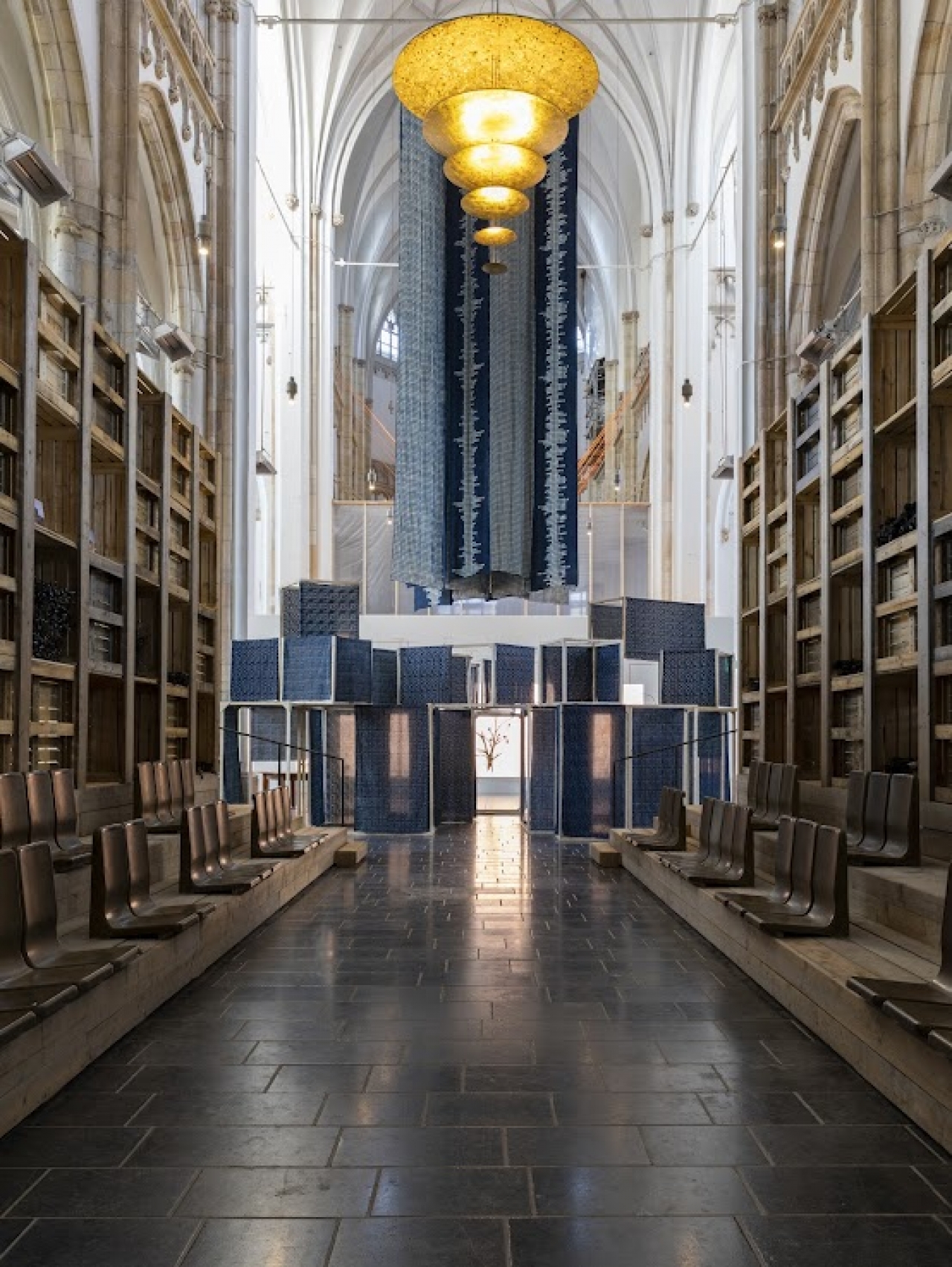
Er is een soundcheck in de Eusebiuskerk tegen de tijd dat ik aankom, waar ze zich voorbereiden op het optreden van Perera Elsewhere later op de avond. De overdreven beschrijvende zinnen die door de geluidstechnicus worden uitgesproken, hoogstwaarschijnlijk op een van hun eerste optredens na de pandemie, gaan over de kerkmuren heen en kaatsen door het Parlement of Ghosts door Ibrahim Mahama. Als je het bekijkt vraag ik me af hoe je de toekomst kunt heroveren van de kadavers uit het verleden.
In de Waalse Kerk zijn er delicate stukken van de Amerikaanse kunstenaar Ellen Gallager – golven, oren en gezichten, gelaagd. De stukken zijn bescheiden, broos, maar toch ingepakt in glas en gepresenteerd op gewogen metalen structuren. Er is een herinnering aan de kunstdistributienetwerken als je naar de titelkaarten kijkt: “Met dank aan de kunstenaar en Houser & Wirth, met dank aan de kunstenaar en Gagosian.” De werken komen ter beschikking via systemen die abstract lijken, ondanks dat de werken zelf tastbaar zijn.
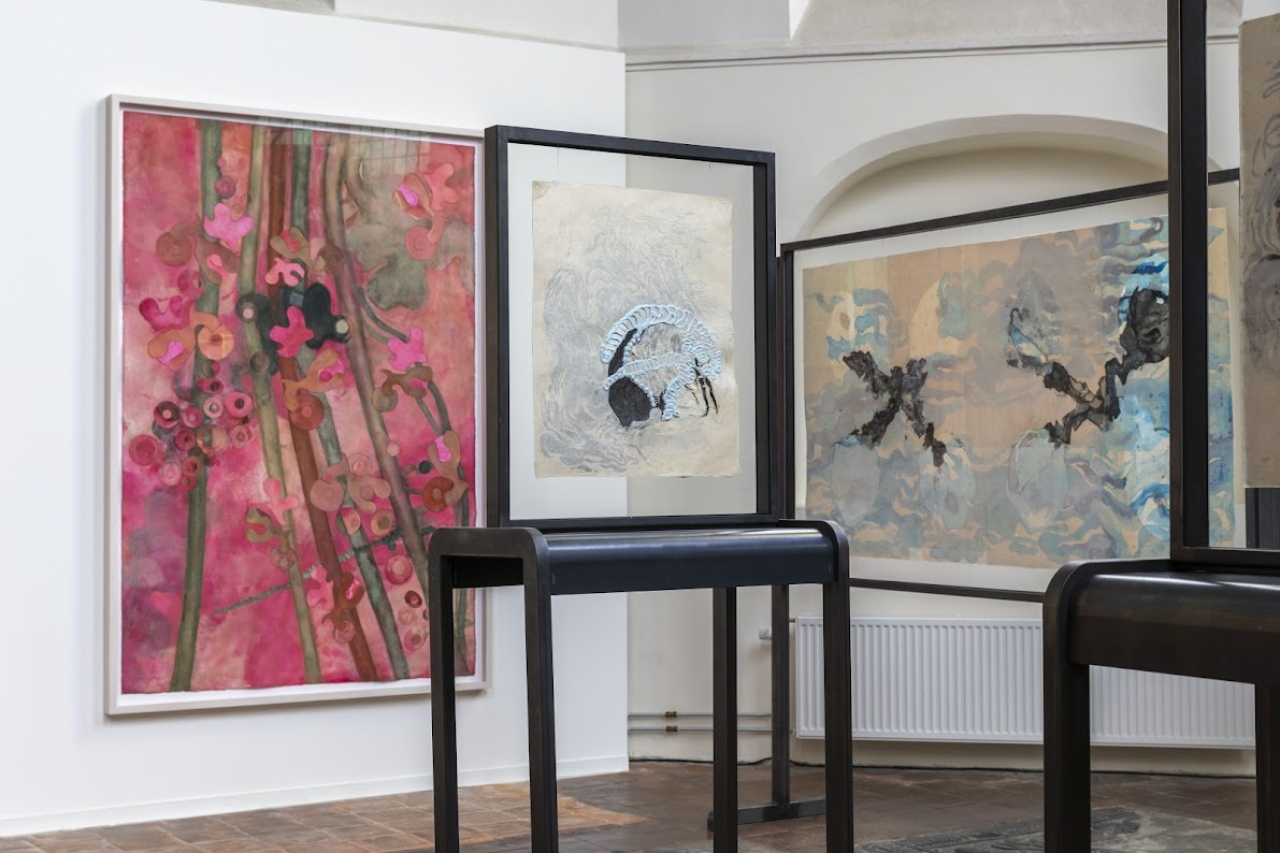
Er zijn overal in Arnhem lege winkeletalages en vacatures die links en rechts gevuld moeten worden.
Bij WALTER Books zijn er verschillende presentaties van vormen van arbeidsverzet. In de boekselectie is er zowel kritiek als lof over en er is het werk van Leo Asemota. De lokale hond kondigt zijn aanwezigheid aan met een officiële oproep aan iedereen die bereid is te luisteren:
“Beste mensen,
Het geluid dat je toesnelt komt van de viervoetige bby Walter, de hond. Ze is buitengewoon blij als de deur opengaat, omdat ze echt van mensen houdt.”
Als ik naar buiten ga, word ik begroet door een hoop flyers: “Wil je meedoen? Meld jezelf aan als vrijwilliger. E-mail… enz.”
Ik heb toespraken gehoord, de reader doorgebladerd en bemerkte de poging om onbetaalde en uitbuitende arbeid zichtbaar te maken. Dus vraag ik me in deze context af; worden vrijwilligers als kunstarbeiders beschouwd? Moet onbetaalde arbeid nog steeds gevraagd worden op een festival dat werkt aan het zichtbaar en gewaardeerd maken van arbeid? Op de website van Sonsbeek wordt de vraag verder niet aangepakt, maar worden een aantal voorwaarden opgesomd:
“Hoeveel tijd wordt er gevraagd aan Sonsbeek 20-24 vrijwilligers?
Antwoord: We vragen om een toezegging van gemiddeld drie dagen per maand. Over de 54 dagen (30 juni – 31 augustus) vragen we om een minimumverplichting van zeven (volledige) dagen. U kunt de dagen in het schema selecteren die het beste bij u passen (al betekent vol, vol).”
Tussen de vrolijke Instagram-storiesvan het festival, die ik geduldig bekijk, dringt de roep om vrijwilligerswerk door.
Ik neem pauze.
Voor het diner bezoek ik vrienden en besluit de gebruikelijke persfestiviteiten over te slaan. Ik krijg een schaaltje spaghetti en overdenk het afgelopen pandemiejaar met de simulatie van een basisinkomen – de TOZO. Een van mijn vrienden vraagt zich af of iemand het afgelopen jaar wel echt gestopt is met werken, terwijl het kapitaal door hen en uit de handen van de staat in de zakken van grondbezitters, supermarkteigenaars en wietverkopers stroomde. Arbeid, of zijn afwezigheid, is wijdverspreid.
In een wereld waarin arbeid weg-geautomatiseerd is en waarin we een stabiel basisinkomen zouden hebben, zou een oproep voor vrijwilligers (een oproep om tijd te vullen) om zijn dagen te wijden aan het ondersteunen van een kunstorganisatie, volledig logisch zijn. Onze wereld is echter imperfect. Arbeidsparadoxen en manieren om tijd te vullen komen nog steeds naar de oppervlakte.
Ik zou graag zien dat Sonsbeek pleit voor een basisinkomen, maar ik weet niet of het onderdeel uitmaakt van hun programma. Hoe tijd in te vullen, komt nog steeds naar de oppervlakte.
Zonder het ooit achterhaald te hebben, vertrek ik naar Amsterdam.
Ik sla Keti Koti over – de symbolische viering van de afschaffing van de slavernij in Suriname in 1863 – maar bemerk hoe Sonsbeek zijn respect betuigt.In de stad waar ik me bevind, biedt Amsterdam zijn excuses aan voor zijn vroegere rol in de slavernij via burgemeester Femke Halsema, die aankondigt: “Namens de gemeentedirectie bied ik mijn excuses aan voor de actieve betrokkenheid van de gemeente Amsterdam in het commerciële systeem van koloniale slavernij en de wereldwijde handel in slavernij.”
Zullen herstelbetalingen aan de eilanden volgen?
—
Deel twee – de terugkomst.
Ik besluit een week na de opening terug te gaan naar Sonsbeek om de werken te laten bezinken, om te zien hoe ze zich ontwikkelen.In Arnhem Centraal passeer ik een vader die piano speelt voor zijn dochter.Ik ga verder met het werk van Willem de Rooij in de showroom, die het Suriname van persfotograaf Pierre Verger shot voor shot terugbrengt naar Nederland. De Rooij approprieert. Er is hier sprake van een ketting van appropriatie. De Nederlander approprieert de Fransman, en de Fransman approprieert beelden van Surinaamse mensen. De Rooij vindt het noodzakelijk om deze beelden weer in omloop te brengen, zoveel blijkt uit zijn gebaar. Er wordt een volledige selectie van tweehonderdzevenenvijftig foto’s weergegeven in een catalogus bij de ingang, evenals in een gespiegelde diavoorstelling, zonder geluid. Maar het verhaal behoort niet aan hem toe. Wist de ene vorm van appropriatie de andere uit, of herhaalt de geschiedenis zich simpelweg, en wordt hier een oude machtsongelijkheid gerecycled?
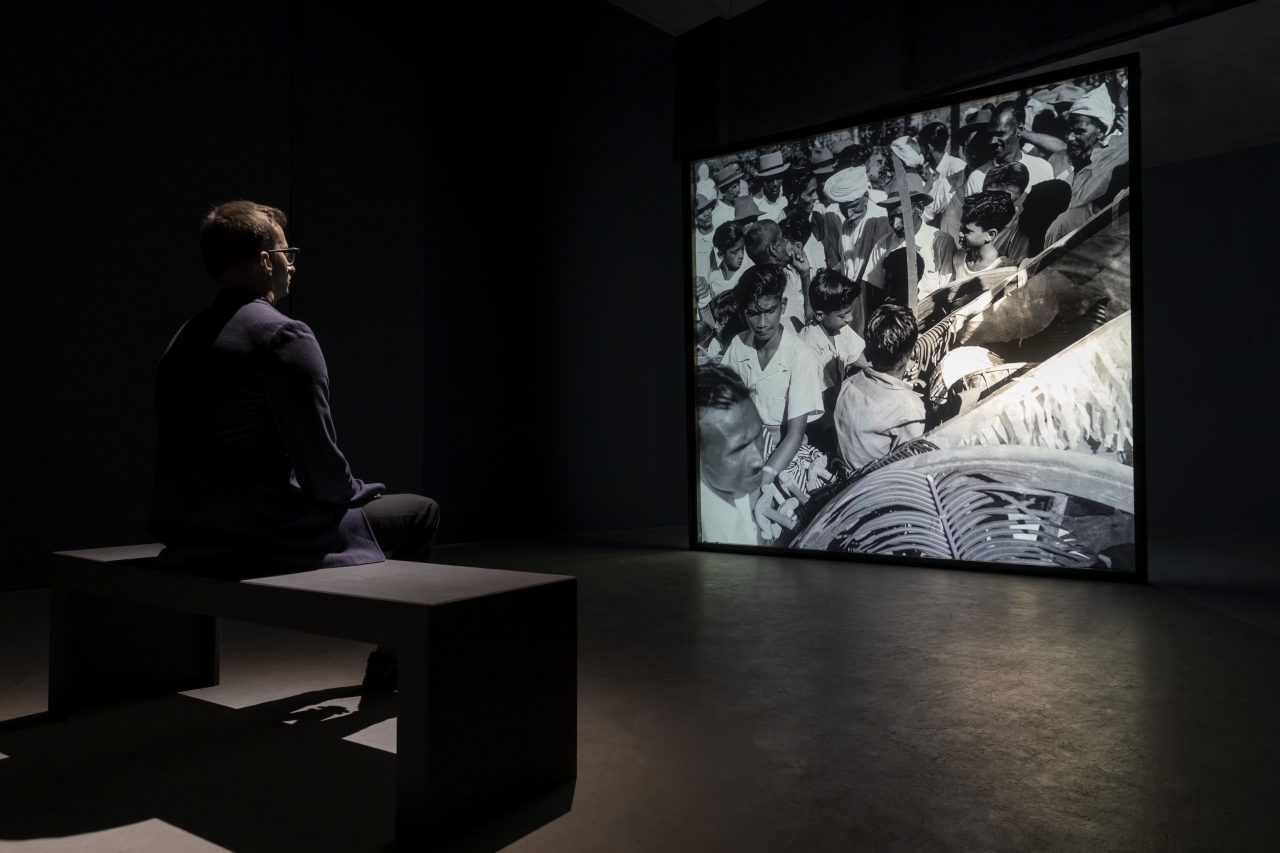
Op de trap van Rozet op de 5e verdieping worden lessen Nederlands gegeven – de studenten leren elkaar complimenteren (“Je hebt een mooie hoofddoek!”), opgedeeld in tweetallen.Naast hen lopen strips uit het archief van Sonsbeek. Ik vraag me af of ze dat merken.
WALTER Books is alleen geopend op donderdag, vrijdag en zaterdag. Door een grappige speling van het lot is de QR-code bij de ingang, die het werk aankondigt “Who produces the worker”, uitgeschakeld en zegt in een vriendelijke vooraf ingestelde toon: “Hey, bedankt voor het scannen. Let op: De QR-code-campagne is om een of andere reden uitgeschakeld.”
Er is wrijving terwijl de werken op hun plaats vallen – en ik hou van wrijving.
Over het algemeen kleeft er een zekere zachtheid en een tijdelijke toestand aan de werken. Ik kom, op een dag met een geelgekleurde waarschuwing voor harde wind, om de Zypendaal park route te verkennen en loop naar de waterval, waar ik zie dat textielstukken links en rechts weggeblazen worden.
Daar kom ik het werk van Werker Collective, Gleb Maiboroda & Studio Bonbon tegen. Op de textielstukken staan werkslogans – voor, tegen, in de verte, van dichtbij. De beschrijving bij het kunstwerk geeft een hint over de inhoud van het werk: “De kernvraag van het project: Hoe kan het design en de artistieke praktijk van Werker Collective opnieuw gearticuleerd worden om een ecosysteem van zorg in balans met natuur en niet-menselijke levensformen mogelijk te maken en te ondersteunen?”
Hoe, inderdaad? De stukken, drijvend op de wind, lijken het antwoord niet te geven.
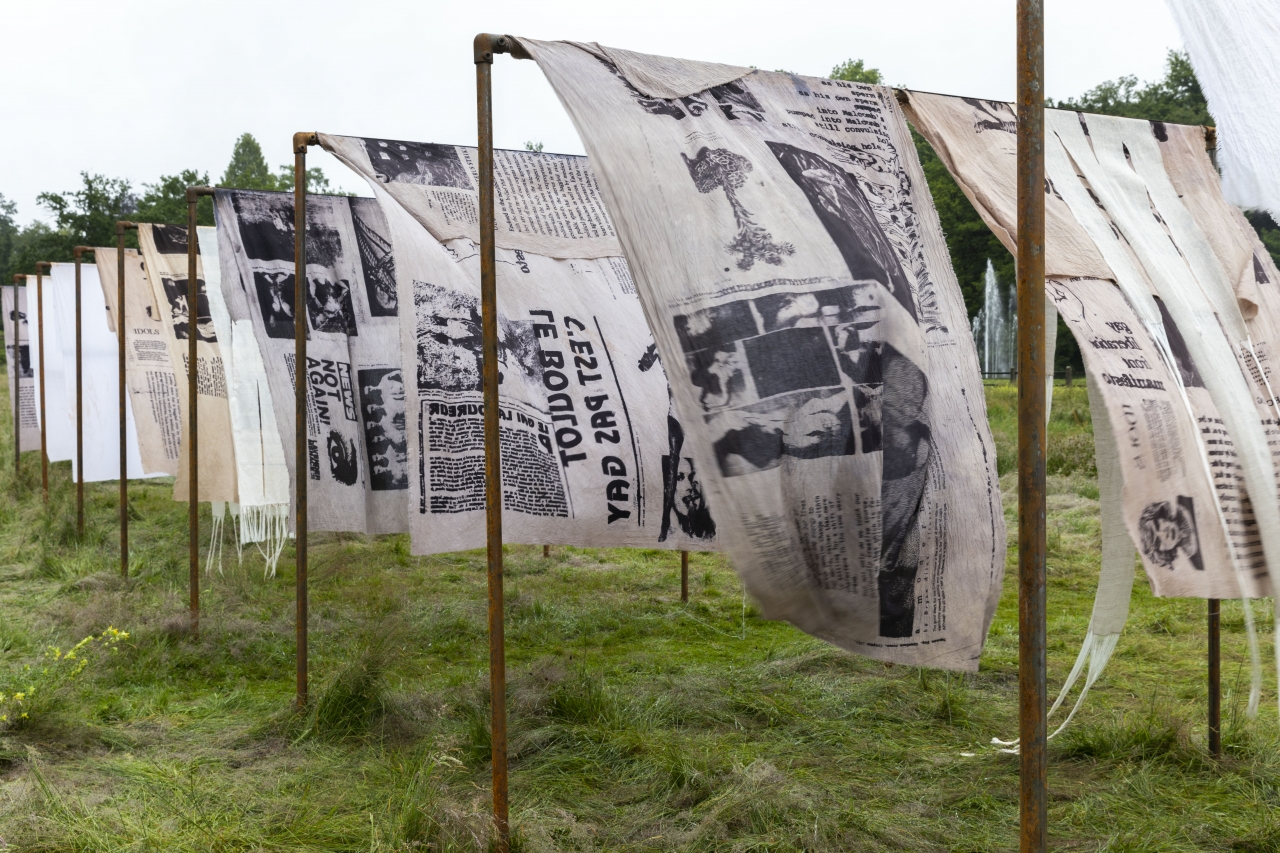
Kwetsbaar gehangen tussen bomen, het werk van Jennifer Tee – Respire, the world begins with trees – en wat later haar bakstenen, uitgehouwen in de bodem van Zypendaal, herinnert aan bomen, wortels en wegen. Ik herinner me dat ik het werk een aantal dagen geleden op Instagram uitgehouwen zag worden in de aarde, dus ik combineer het beeld van de bakstenen met de onvermijdelijke herinnering aan arbeid. Erop staan voelt nog steeds precair.
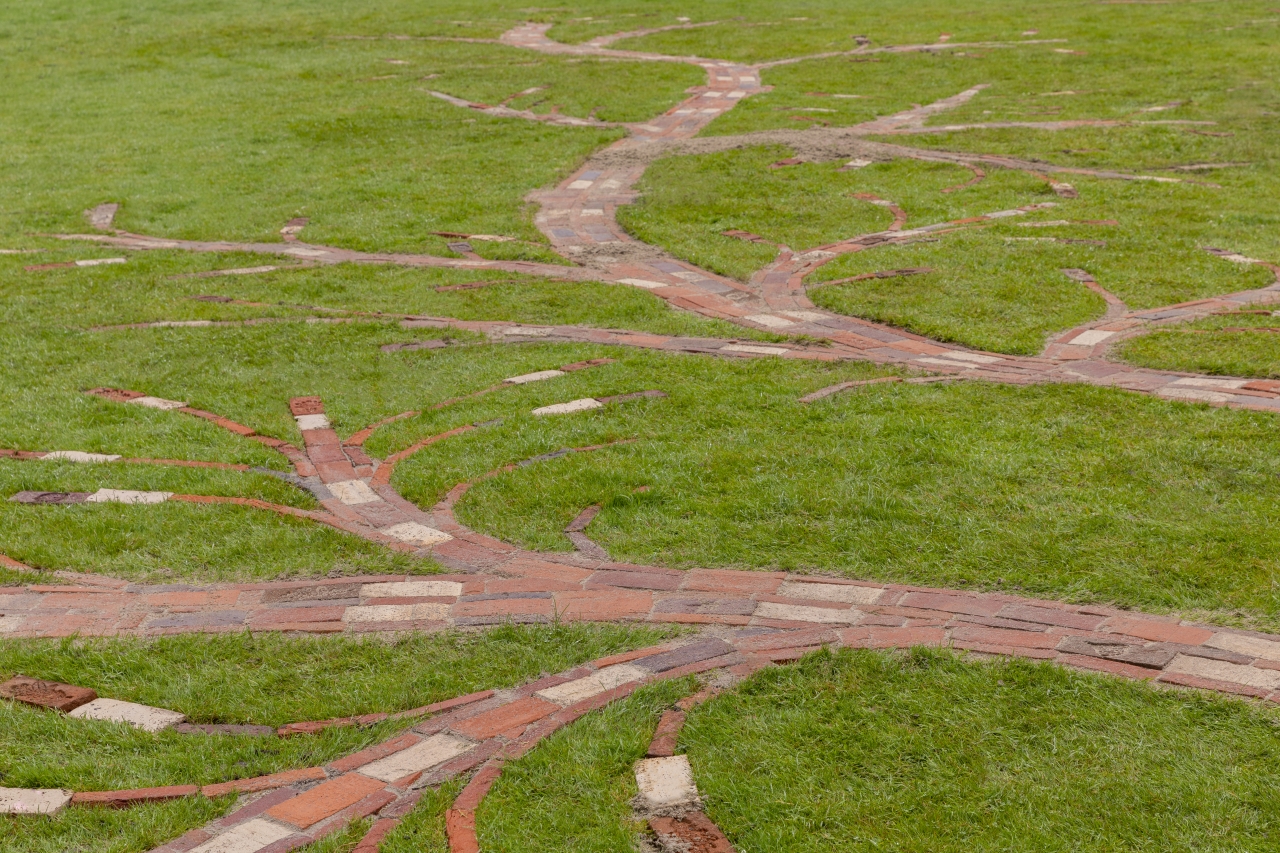
En er is het paviljoen van raumlabor aan de Grote Vijver, gemaakt uit gerecycled hout, textiel, piepschuim en een steen van de Saale-gletsjer: een paviljoen dat op het water drijft, en je kan meedrijven.
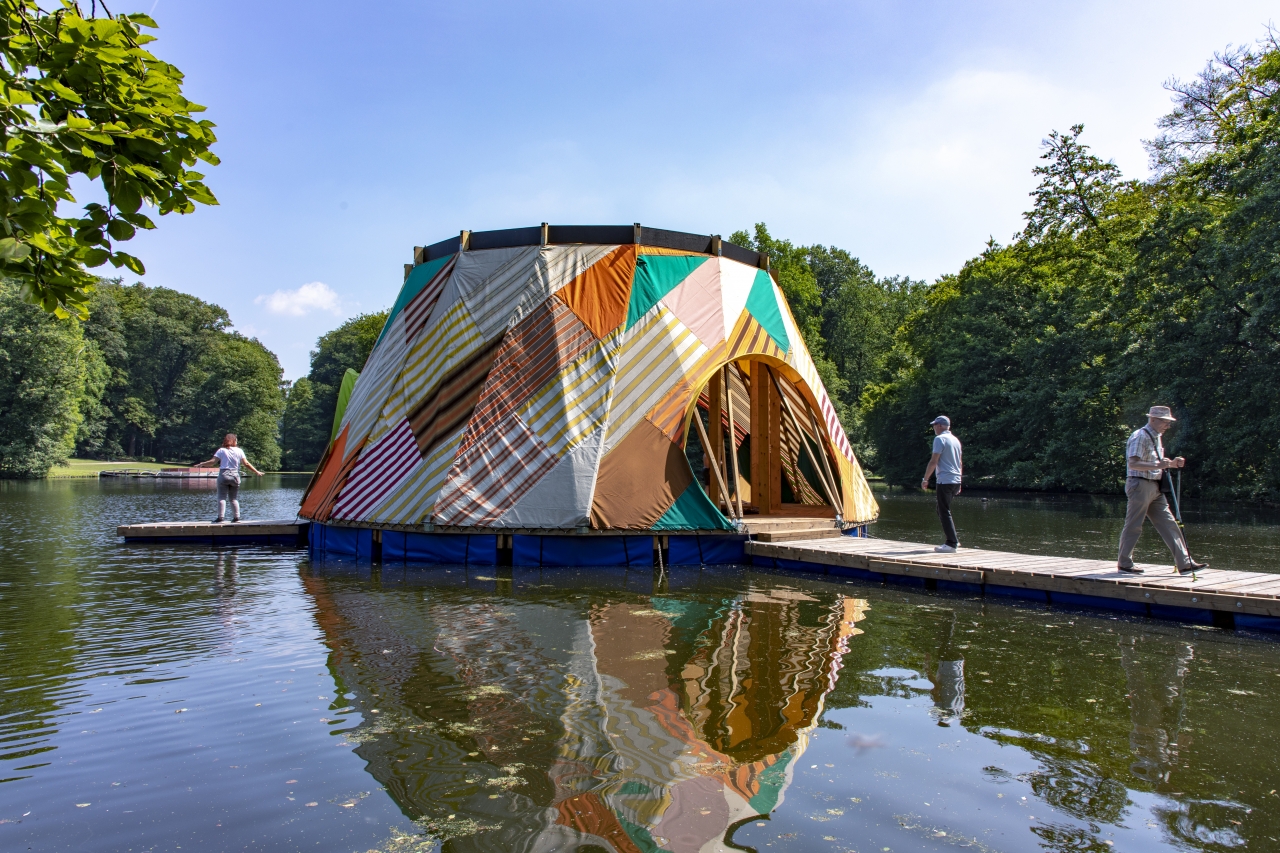
En dan is er Wendelien van Oldenborghs paviljoen gemaakt van hout en juten, met een videoscherm dat kapot ging in de eerste week en was afgezet. Als het gewerkt had, zou het een videowerk afgespeeld hebben van Lyana Use, Tirza Hiwat, Josephine Spit, Pelumi Adejumo en Lara Nuberg, die praatten over “hybridity, transnationality and diasporic sensitivity.”In plaats daarvan lagen de kabels los en hield de vermoeide technicus een pauze tegen de tijd dat ik aankom. Er bestaat blijkbaar nog steeds arbeid.
Er is historie in villa Sonsbeek. The Black Archives en Yinka Ilori leggen zich toe op het documenteren van hoe de villa en het park gebouwd werden: door koloniale exploitatie in Suriname, Indonesië en de andere Nederlandse kolonies, van de tijd dat deze nog toebehoorden aan de adel.
En via The Black Archives – aantonend dat de exploitatie nooit stopte – wordt eindelijk een poging gedaan om herstelbetaling te eisen.
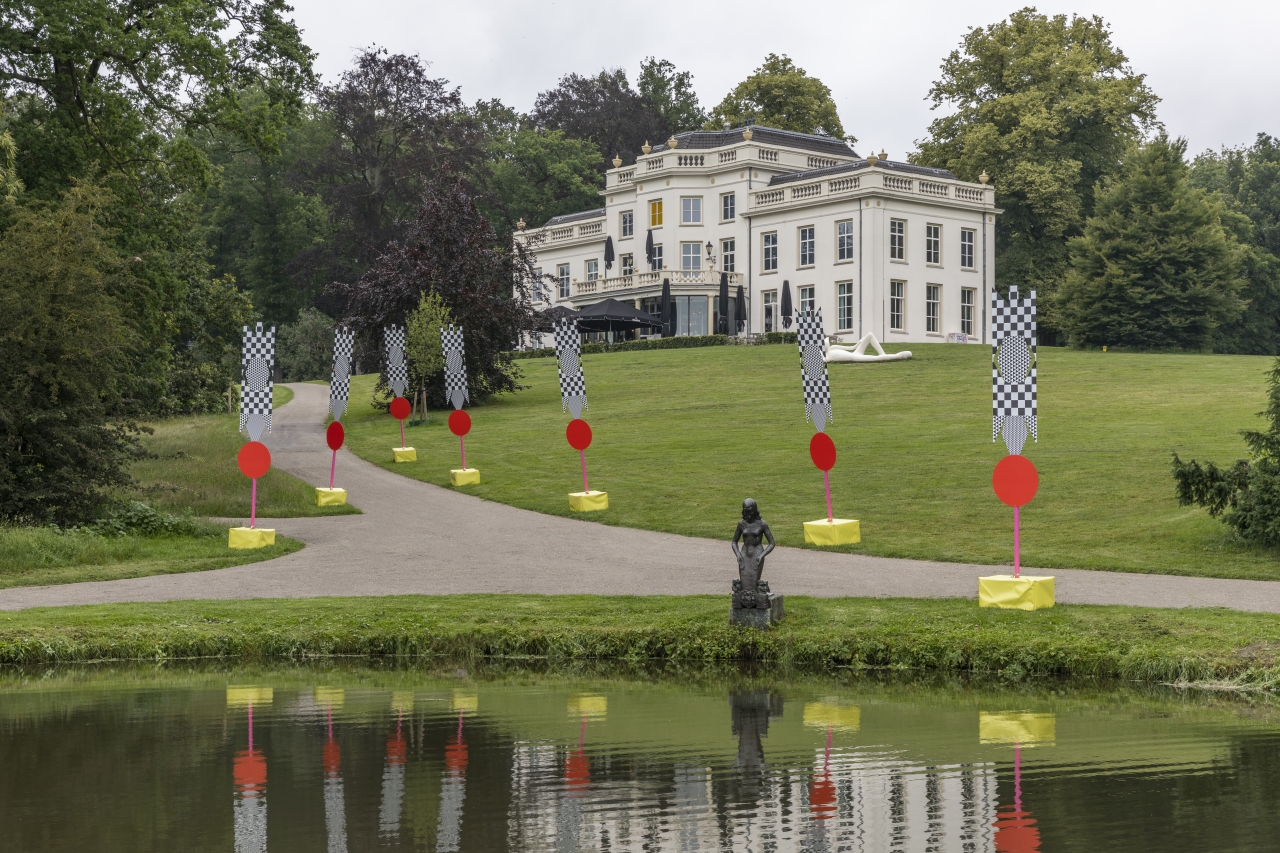
Een week na mijn tweede bezoek mailde een vriend me de inhoud van een kleine Black Archives-presentatie, gehouden door Mitchell Esajas. Ik quote mijn vriend:
“Ik ging naar de kerk en luisterde naar het verhaal van ‘black Anna’, die hier in Arnhem op het Zypendaal-domein leefde, waar ik de tuinen dikwijls bezoek. Ze werkte hier van 1727 tot 1780 als dienstmeid. Ze was verscheept van de plantage Vossenburg (Suriname). Één van de mensen van The Black Archives vond een afstammeling van die plantage en aangezien ze uitgenodigd werden om iets aan de tentoonstelling toe te voegen, besloten ze een fotoshoot te doen in de tuinen. Omdat het zou gaan regenen, belden ze de eigenaars, vertelden hen over hun onderzoek en hun plannen en vroegen hen of zij het huis mochten gebruiken om zich tijdens de shoot om te kleden. De eigenaar zei ja; voor tweehonderdvijftig euro per uur. Daarop stuurden de mensen van The Black Archives een factuur terug.”
De factuur omvat de historische herstelbetalingen en Anna’s onbetaalde werk, verrekend met de 3-uurse opnamekostenin park Zypendaal. Het totale openstaande bedrag, dat de eigenaars van het landgoed zouden moeten betalen, zweeft ergens rond €6.499.738,50.
Ik denk aan alle vrienden die niet kunnen reizen, ofwel vanwege financiële redenen ofwel vanwege persoonlijke verplichtingen of fysieke mankementen. Ik denk aan wie waar toegang toe heeft en ik waardeer het trage binnensijpelen van beschrijvingen via social media, die mogelijk de angst uitlokken iets te missen, maar voor anderen het gat vullen in een programma dat ze anders nooit zouden hebben meegemaakt. Ik bejubel de verhalen,hoe geschiedenis wordt geactiveerd en hoe verhalen gebruikt kunnen worden als vorm van verzet.
Sonsbeek duurt vier jaar, en dus kan ik inhalen. Ik zal het proberen. Tegen die tijd kunnen de werken allemaal functioneren of kunnen ze allemaal geleidelijk uit elkaar zijn gevallen. De meest krachtige werken zijn wellicht de verhalen die hulp nodig hebben om naar de oppervlakte gebracht te worden.
Ik kom terug, maar ik stop er ook mee. Ik zal rust nemen, als verzet tegen de arbeid van het kijken, luisteren en geven van mijn aandacht.
The work begins (the work never stopped), you can hear it from a distance
on Sonsbeek (force times distance), on labour and its sonic ecologies, in two trips, and maybe more to come
I’m physically late for the press preview on June 30th, but I tune in. I watch the opening of the Sonsbeek quadrennial exhibition in Arnhem, taking place in the Eusebius church, in between a zoom meeting to organize a festival, and an in-person appointment to pick up a new pair of Airpods in Amsterdam. After having lost the left one a month earlier, I listen (with only my right ear) via an Instagram livestream, to which a couple of dozen other people tune in. A stream of choir music and speeches (the festival director: Bonaventure Sou Bejeng Ndikung, one of the curators, Amal Alhaag) trickle into my right ear as the noise of midday traffic trickles into the left.
At lunchtime I slid my new paid of Airpods – designed in California, made in Vietnam, distributed via Ireland – into my backpack and set for the station to get to Arnhem.
For this piece, I will be paid 0.20 cents per word. And my translator will receive a fee of 250 Euros.It makes sense to list it. This piece and Sonsbeek itself riff about labour, about ecology, about soundscapes. About how one can organize a distributed exhibition starting in 2021, based on these topics. It’s a challenge trying to encompass it all so I won’t even pretend to manage.
Once at Molenplaats, in park Sonbeek, I sit down, order a coffee and both catalogs of the exhibition from an intern that forgets to ask me for money. I think to myself: “This must be bliss! We’ve arrived in a post-work utopia!”, until her supervisor indicates that I should be paying and we’re brought gently back to earth. She hands me the catalogs, a tote bag and a plastic bottle of water branded with the Albert Heijn logo, while I pinch myself and try to understand where I am. A flyer on the table helps me. I’m in “A beautiful mess”, an initiative that offers paid jobs to people with a refugee background, via learning trajectories. It is a sleek way to integrate the theme of the show, but not part of the show itself.
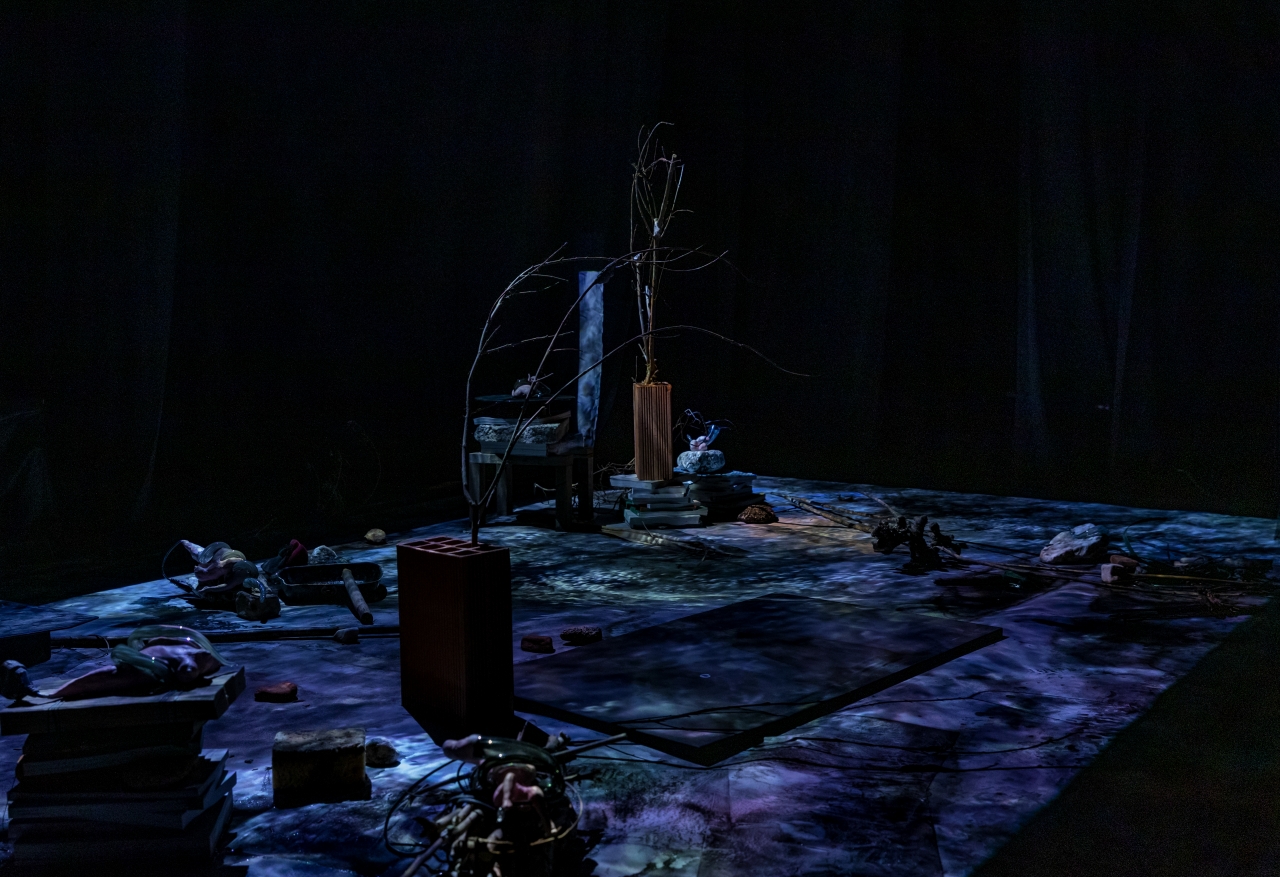
I decide to take the unguided route and step into the wayside. I think of myself as a regular visitor, so I miss much of the festivities.
I meander through the Green route to DE.GROEN, where I encounter an olfactory trip from vanilla to squid ink, from the top and through the gift store down into the basement. It’s the first day, things are unfinished. A series of instructions lie on the bench next to the squid ink work of Laure Prouvost; the notes are handwritten and discuss everything from how to take care of the electronics to how to take care of the audience. Ideally, the spectators would be served tea.
On the opening press day, Showroom Arnhem is closed. Instead of it, I stumble across an Appeltje Eitje – what would happen if a FEBO got crossed with an automatic supermarket check-out and a farmers market – and I try to imagine which artist it would belong to. In it, the employees have been automated out of the picture. Some stories of farmer’s origins and prerecorded videosfill the walls and one is free to use a self-check-out and a wall full of fresh produce (fruit, eggs, milk, chicken meat to follow and pay on the display – contactless of course). The store sleekly seems to integrate what I later on discover Sonsbeek doesn’t really tackle – the future of work in terms of the presence of automation.
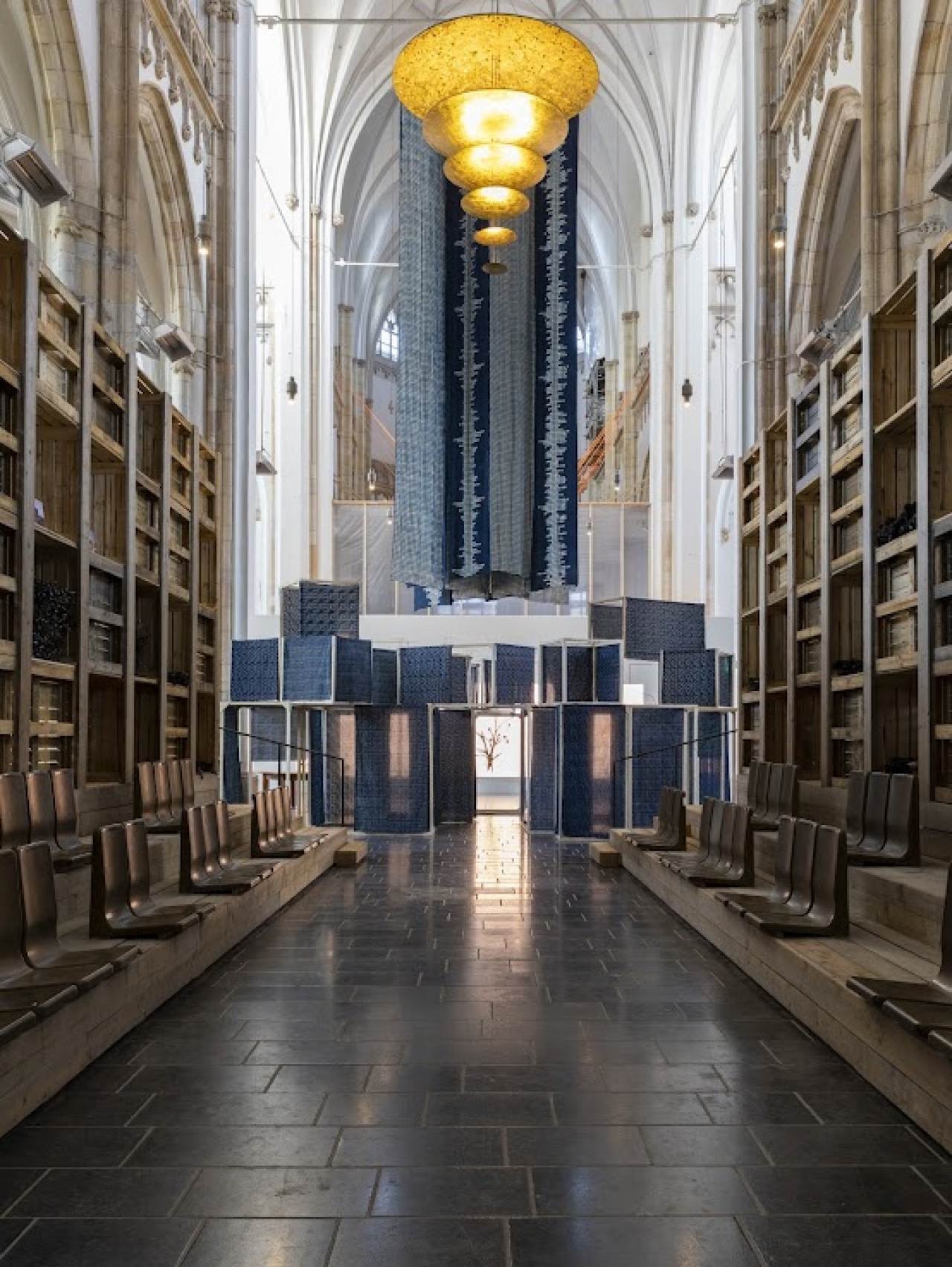
There is a soundcheck at the Eusebius church by the time I arrive, where they are prepping for the performance of Perera Elsewhere later in the evening. The overly descriptive sentences uttered by the sound engineer, most likely on one of their first gigs after the pandemic, ring across the church walls and bounce across the Parliament of ghosts by Ibrahim Mahama. Looking at it I wonder how one can reimagine the future from the carcasses of the past.
In the Waalse Kerk there are delicate pieces by US artist Ellen Gallager – waves, ears and faces, layered. The pieces are humble, frail, yet encased in glass and on weighted metal structures. There’s a reminder of art distribution networks when one looks at the title cards: “courtesy of the artist and Houser & Wirth, courtesy of the artist and Gagosian.” The works become available via systems that seem abstract, despite the works being tangible themselves.
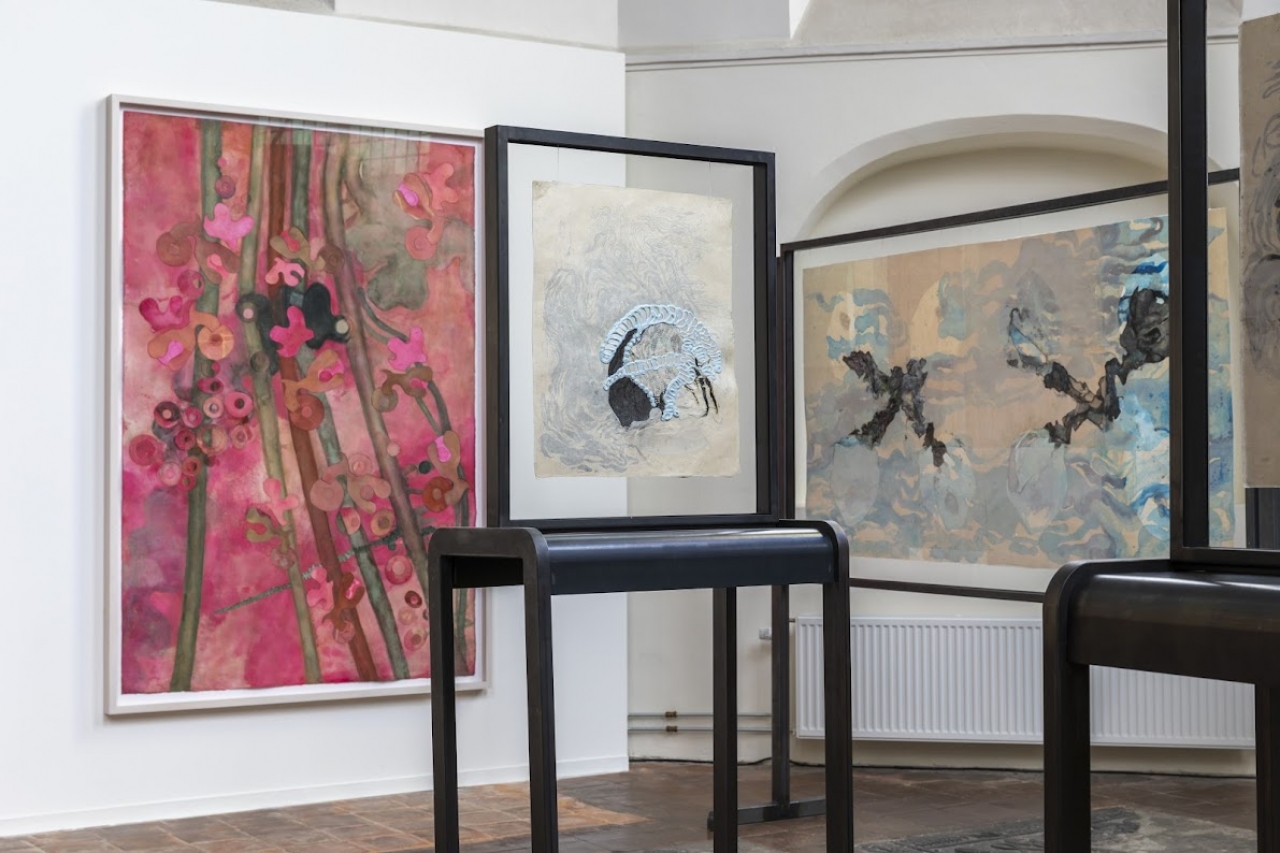
There are empty shop fronts and open positions to be filled left and right throughout Arnhem.
At WALTER books there’s a scattering of labour resistance. In the book selection, there’s criticism and also praise of it, and there’s the work of Leo Asemota. The local dog announces its presence in an official address to anyone willing to listen:
“Dear people,
The sound rushing towards you comes from four-legged bby Walter, the dog. She is extremely joyful when the door opens, because she really likes people.”
As I exit, I’m greeted by a pile of flyers: “Want to participate? List yourself now as a volunteer. Email… etc.”
I heard speeches and leafed through the reader and noticed the nod to making unpaid and exploitative labour visible. So in this context, I wonder, are volunteers considered art workers? Should unpaid labour still be asked for at a festival that works on making labour visible and valued? The Sonsbeek website goes on to not tackle the question, but lists conditions:
“How much time commitment is being asked of Sonsbeek 20-24 volunteers?
Answer: We are asking for a commitment of an average of three days per month. Over the 54 days (30 June – 31 August), we ask for a minimum commitment of seven (full) days. You can select the days in the schedule that suit you best (although full means full).”
In between the perky Instagram stories of the festival, through which I flip patiently, the call to volunteer presses through.
I take a break.
For dinner I visit friends and decide to skip the usual press festivities. I’m served a bowl of spaghetti and overthought the last pandemic year with its simulation of a basic income – the TOZO. One of my friends ponders whether in the last year anyone truly stopped working, as capital flowed through them and from the state’s hands into the pockets of landlords, supermarket owners and weed sellers. Labour, or its absence, is scattered throughout.
In a world in which labour has been automated out of the picture and in which we’d have a stable basic income, a call for volunteers (a call to fill up time) to dedicate one’s days to supporting an arts organization, would make perfect sense. Our world though is imperfect. So paradoxes of labour and how to fill up time still come to the surface. I’d wish for Sonsbeek to advocate for a basic income, but I don’t know if it’s part of their program.
Never really having found out, I leave for Amsterdam.
I skip Keti Koti – the symbolic celebration of the abolition of slavery in Suriname in 1863 – but brush up on its meaning and notice how Sonsbeek is paying its respects. Where I am, Amsterdam brings its apologies for its past connections to slavery through mayor Femke Halsema who announces: “On behalf of the municipal executive, I apologize for the active involvement of the Amsterdam City Council in the commercial system of colonial slavery and the worldwide trade in enslaved people.”
Will reparations to the islands follow?
—
Part two – the return.
I decide to go back to Sonsbeek a week after its opening. I decide to let the works sink in, to see how they evolve. In Arnhem Centraal I pass by a father playing the piano for his daughter. I move on to the work of Willem de Rooij at the Showroom, who brings press photographer Pierre Verger’s Suriname shot after shot back to the Netherlands. De Rooij appropriates. There’s a chain link of appropriation. The Dutch, appropriates the French, who appropriates the images of the Surinamese people. De Rooij finds it necessary to place the images back in circulation, this is what explains his gesture. There’s a full selection of 257 pictures displayed in a catalog at the entrance, as well as in a mirrored slideshow, with no sound. But the story is not his. Does one appropriation erase the other, or is it just history repeating itself, recycling a power imbalance?
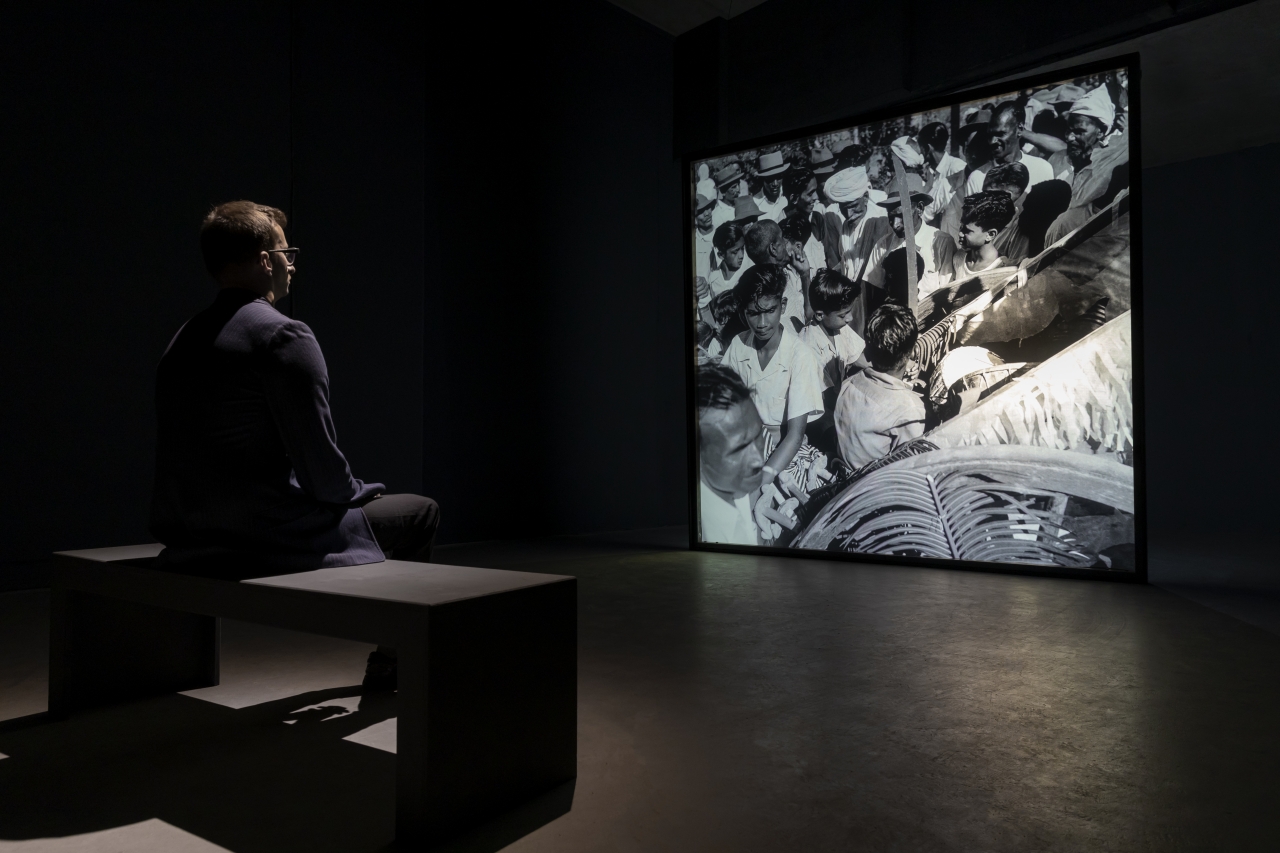
Dutch classes are being held on the stairs of Rozet on the 5th floor – the students learn to compliment each other (“You have a beautiful headscarf!”), as they pair up two by two. Alongside them run strips from the archive of Sonsbeek. I wonder if they notice.
WALTER books is only open on Thursdays, Fridays and Saturdays. Through some funny twist of fate the QR code at its entrance, announcing the work “Who produces the worker”, is disabled, stating in a friendly pre-set tone: “Hey, thanks for scanning. Notice: the QR code campaign has been disabled for some reason.”
There’s friction as the works settle in place – and I love friction.
Overall there’s a certain softness and temporary state to the works. I arrive on a day with a yellow-coloured weather warning for wind, to tour the Zypendaal park route and I walk up to the waterfall noticing textile pieces being blown away left and right.
There, I encounter the work of Werker Collective, Gleb Maiboroda & Studio Bonbon. On the textile pieces there are work slogans – for, against, in the distance, up close. The work description hints at the content of the work: “the project’s core question: How can Werker Collective’s design and artistic practice be re-articulated to enable and support an ecosystem of care in balance with nature and non-human forms of life?”
How indeed? The pieces, flowing in the wind, don’t seem to have an answer.
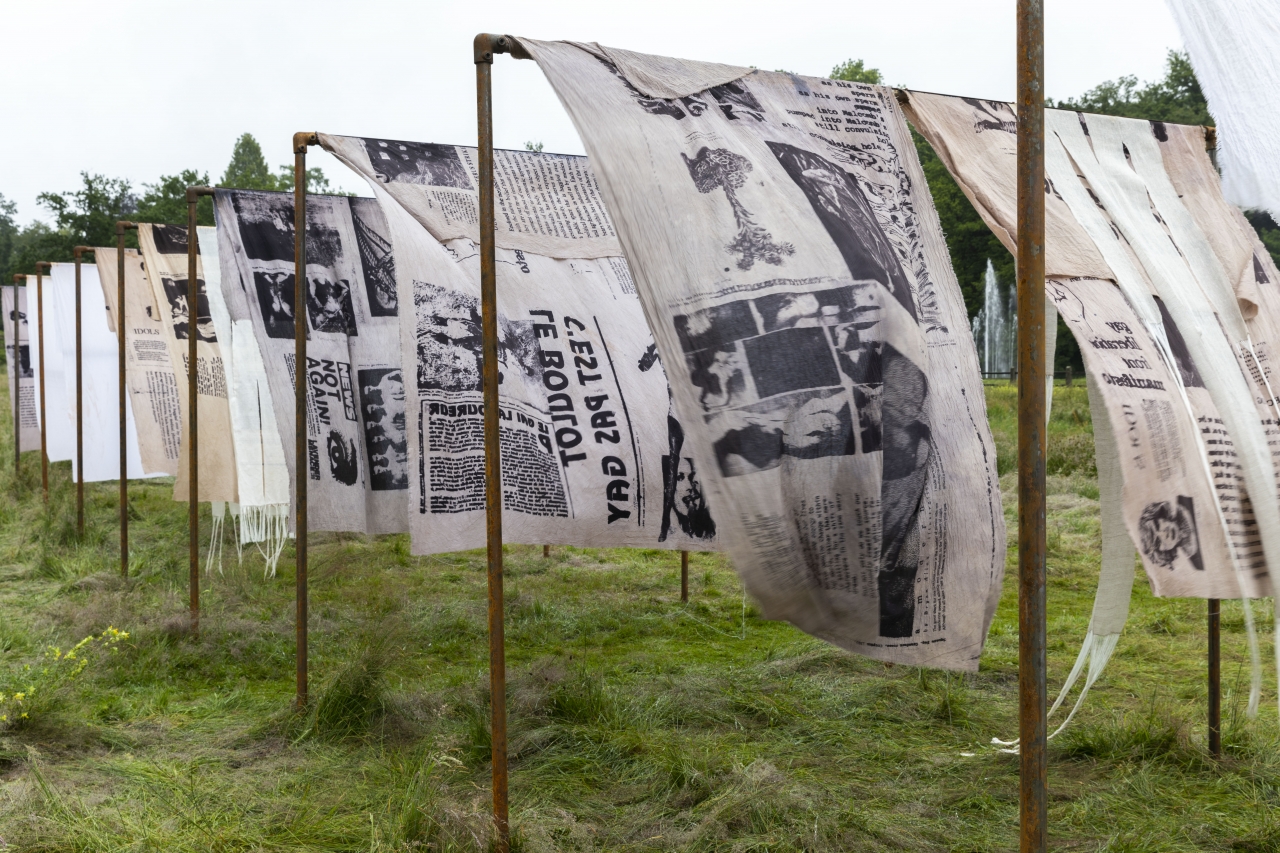
Flimsily strapped across trees, the piece from Jennifer Tee – Respire, the world begins with trees- and later on her bricks carved in the soil of Zypendaal, remind of trees and roots and roads. I remember having seen the work being carved into the earth a few days ago on Instagram, so I overlap the bricks with the inevitable memory of labour. Stepping on them still feels precarious.
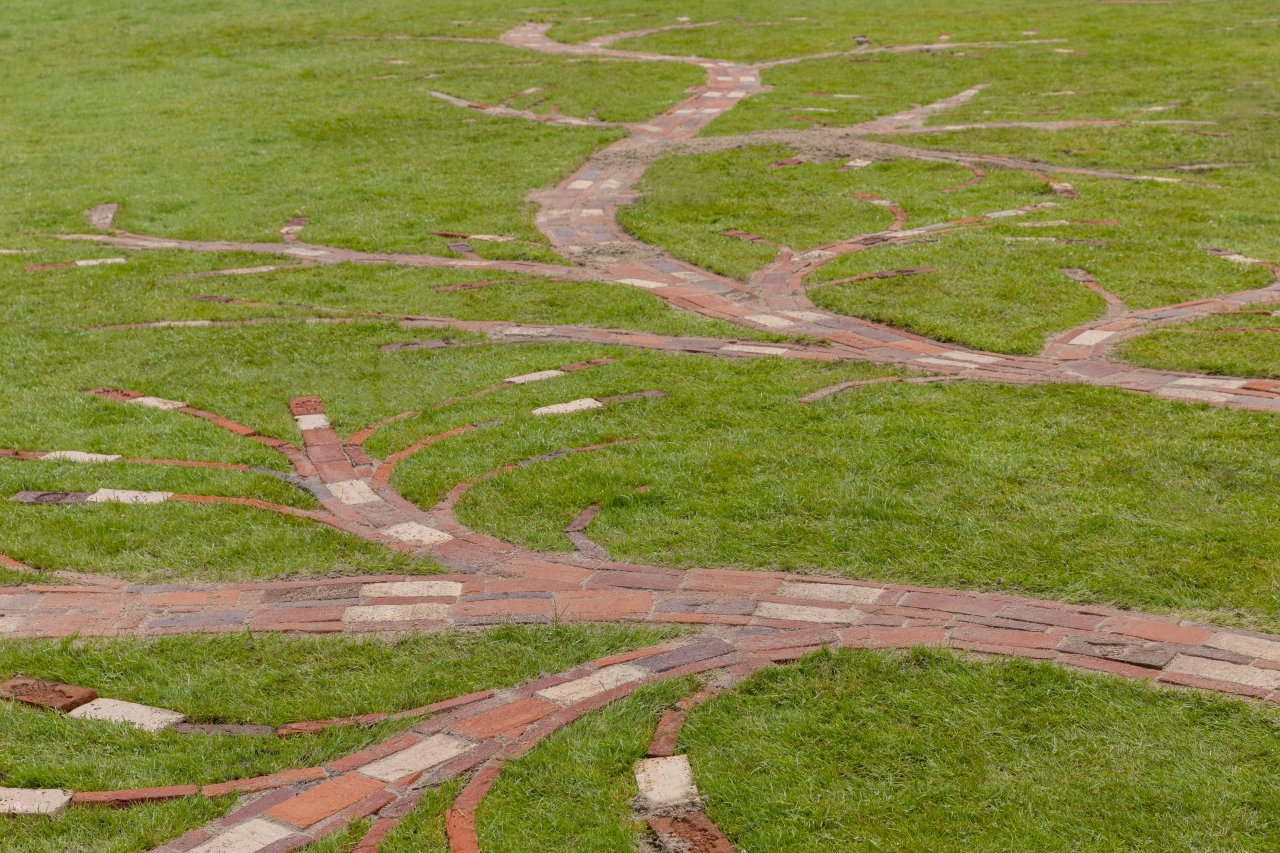
And there’s raumlabor’s pavilion at the Grote Vijver, made of repurposed wood, textile, styrofoam and a rock from the Saale glaciation: a pavilion that floats on the water, and you can float with it.
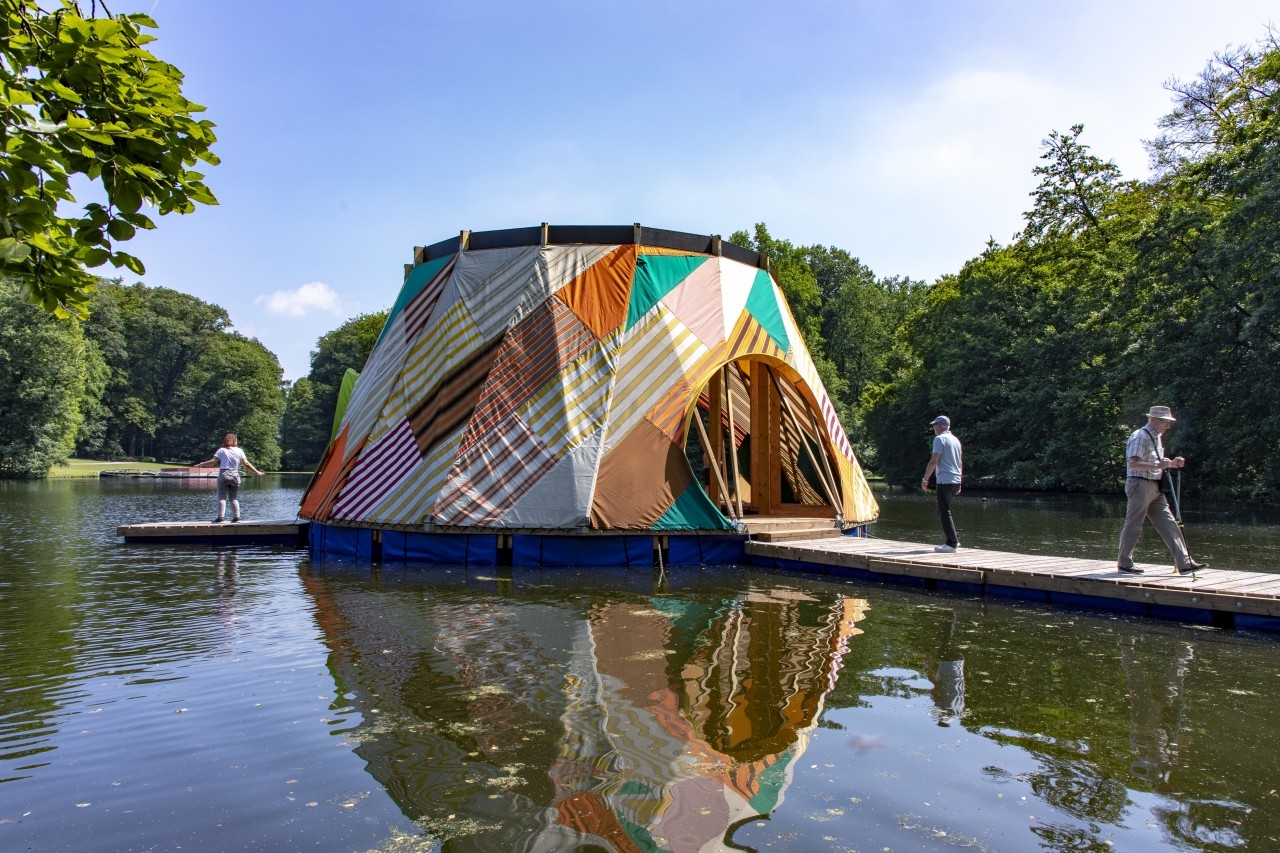
And then there’s Wendelien van Oldenborgh’s pavilion made of wood and jute, with a video display that had given up had broken down in one week and had been cordoned off. If it would have functioned, it would have shown a collaborative video with Lyana Use, Tirza Hiwat, Josephine Spit, Pelumi Adejumo and Lara Nuberg, talking about “hybridity, transnationality and diasporic sensitivity”. Instead, the cables are out and one tired technician takes a break in fixing it by the time I arrive. Apparently there’s still labour.
There’s history in the villa Sonsbeek. The Black Archives and Yinka Ilori dedicate themselves to documenting how the villa and the park were built; through colonial exploitation in Suriname, Indonesia and the other Dutch colonies, from the time in which they were still estates belonging to the nobility.
And via The Black Archives, showing the fact that exploitation never ended, an attempt at demanding reparations is finally made.
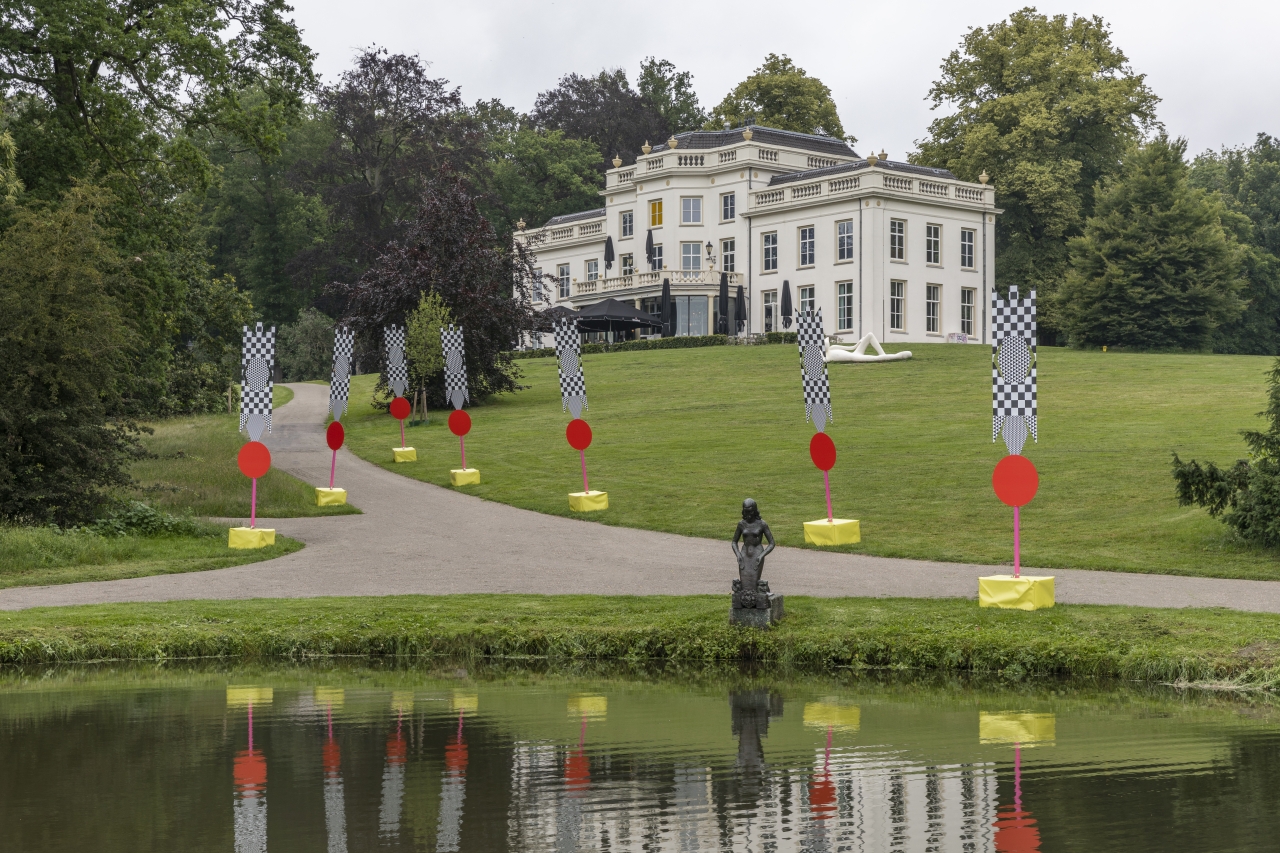
A week after my second visit, a friend starts trickling the content of a small Black Archives presentation held by Mitchell Esajas into my inbox. I quote my friend:
“Went to church and listened to the story of “black Anna”, who used to live here in Arnhem at the estate Zypendaal, whose gardens I often visit. She worked there from 1727 until 1780 as a dienstmeid. She was shipped from the plantage Vossenburg (Suriname). One of the people from the Black Archives found a descendant from that plantage and since they were invited to contribute something to the exhibition, they decided to do a photoshoot in the gardens. Since it was going to rain they called the owners, told them about their research and their plans and they asked if they maybe could use the house for changing clothes during the shoot. The owner of the estate told them yes; for 250 euros an hour. So the people from the Black Archives made an invoice back.”
The invoice listed the historical reparations and Anna’s unpaid work calculated against a 3-hour recording fee in Zypendaal park. The total open amount hovers around €6.499.738,50, which has to be paid by the estate owners.
I think of all the friends that can’t travel, either because of financial reasons or due to personal obligations or physical impairment. I think of who has access and to what and appreciate the slow trickling in of descriptions via social media that might trigger some fear of missing out, but for others fill the gap of a program that they otherwise might have never experienced. I rejoice in the stories, at how history is activated and how stories can be used as a form of resistance.
It will take four years to catch up. I’ll try. By then, the works might all function or they might all have gradually decomposed. The most powerful works might be the stories which need a hand in being brought to the surface.
I’ll return, but I’ll also drop out. I’ll take a good long rest, as resistance to the labour of viewing, listening and offering my attention.

